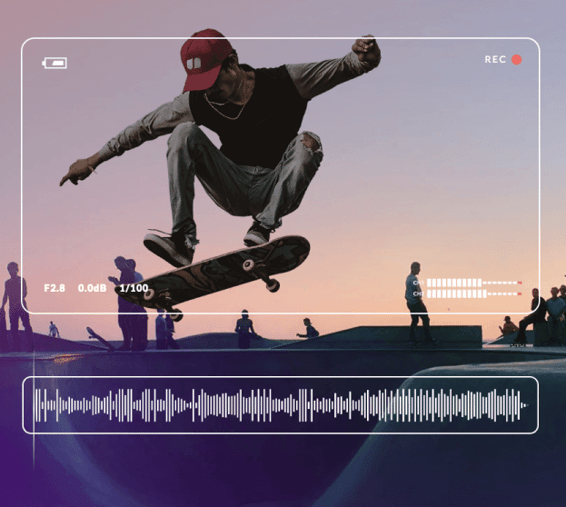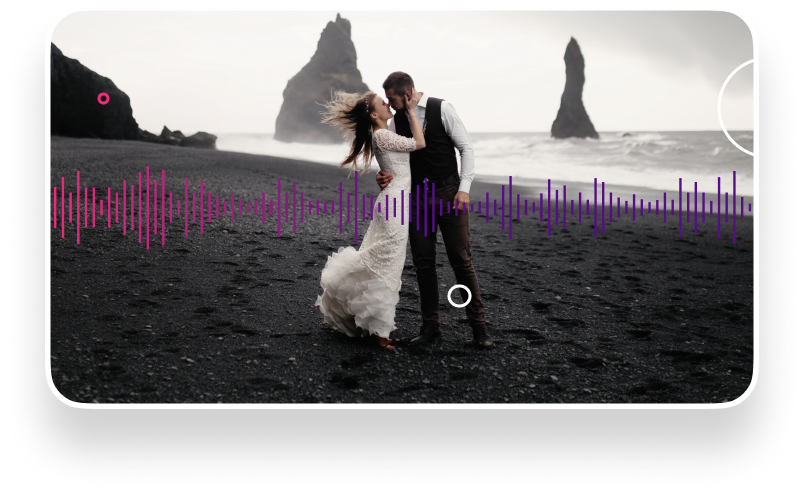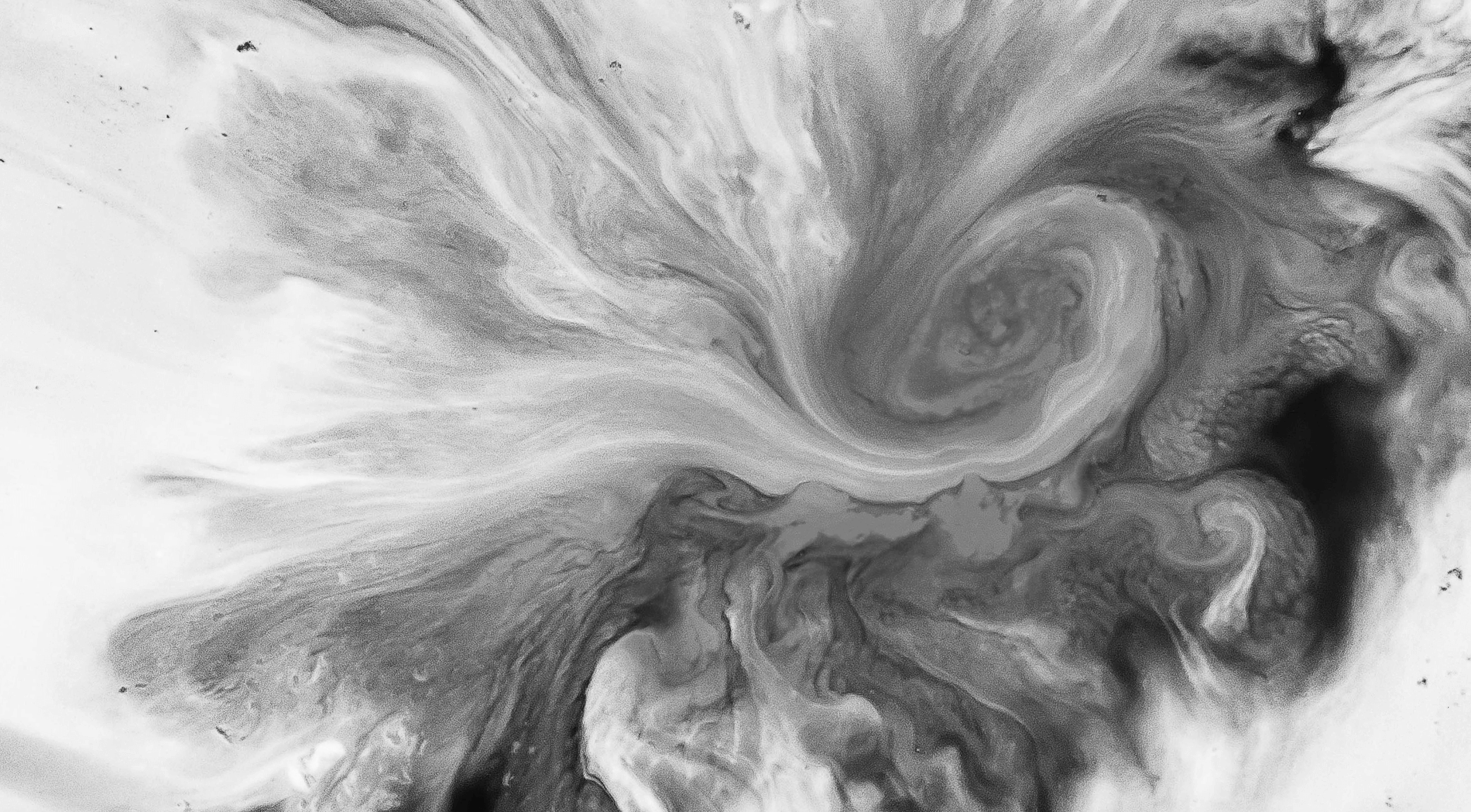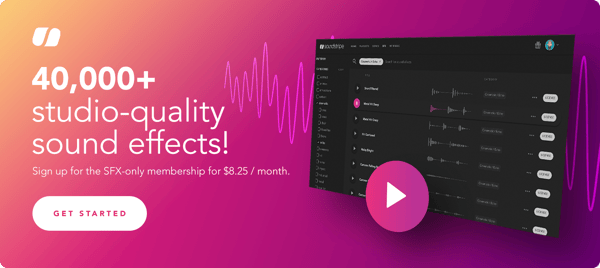YouTube Sound Effects






Listen to our Best YouTube Sound Effects
We know the right sound effect can make or break your project. That’s why every file in our library is vetted by award-winning producers. Hear for yourself. We've curated a playlist with our best YouTube sound effects.
Looking for something different?
We got you. From classical to hip hop to indie, our audio library contains thousands of outstanding tracks. Use one of our 13 filters or check out other curated playlists to find what you need in minutes.
BROWSE THE FULL CATALOG
Dead Simple Licensing
Never worry about licensing again. With Soundstripe, your membership covers the cost for every song license. Just find the right track, download the file, and get a custom license. That’s it. No channel or media-specific fees, no recurring royalties, ever. Here’s more good news: you have unlimited licenses. Go ahead, download as many songs as you want.
Content Creator’s Guide To YouTube Sound Effects (And Why You Need Them)
Sound effects make films great. Sure, we pay attention to the visuals more than anything, but it’s the sound design that really pulls us into the worlds, stories, and emotions of any video.
Of course, “video” doesn’t just cover huge Hollywood blockbusters, or indie films, or even advertisements. As a content creator, you can use sound design as a tool to push your channel to the next level. And sound effects play a major role in that.
To understand why sound effects matter, we’ll have to visit two different topics: the silent film era (where sounds effects came from) and the human brain (how sound influences us).

The Origin Story Of Sound Effects
Waaay back before The Jazz Singer (1927), watching a film was a novel experience...but it was also a quiet one. Recording soundtracks fell flat in a lot of areas, and rarely captured everything on screen. If you watch one of those films now, you can’t help but feel separated from the characters, stories, and events.
Even the addition of live orchestras didn’t quite address that issue. It gave filmmakers a little more emotional impact to work with, since they could have more control over how audiences experienced the movie.
But it was the introduction of sound effects (and specifically pairing audio channels with film reels) that revolutionized both the film industry and how we as humans experience entertainment.
Sound effects have their origin story in radio. Unlike movie theaters, home radios provided exclusively audio experiences for people around the world. In order for these programs to present a mysterious or dramatic narrative, broadcast companies need another layer of storytelling.
So, broadcasters began hiring sound engineers. They wanted people who could create sounds like footsteps and animals, and they needed these artists to work as live performances alongside the voice actors.
These specialists are known as Foley artists. They’re those oddballs who sit in a studio full of junk, smash vegetables, and somehow turn that into the sounds of a fistfight. And the results of their work are usually the pieces that make a movie feel so believable.
Jack Foley — widely considered the founding father of sound design — pioneered the concept, which is why it’s named after him. But Foley also made the jump from creating sound effects for radio to creating them for motion pictures.
When Universal Studios started work on The Jazz Singer, they started looking for sound engineers, often luring them away from broadcasting jobs with the allure of the big screen.
When it came to film, these early sound pioneers would watch a film and try to produce sounds to fill in for things that the on-set microphones failed to pick up. Basically, it meant that instead of imagining sound effects for radio, these sound engineers got to recreate sounds for film.
And they quickly realized that “movies with sound” were a whole lot more impactful and emotional than the silent films they were replacing.
How Sound Affects The Human Brain
The impact of sound effects changed multiple industries back in the 1900s, but we can still see the results of that in modern filmmaking.
And if production teams are still hiring sound engineers and designers, that only validates the need for sound effects in modern media. It’s how directors build worlds, pump emotions into scenes, and build on the storytelling of the visual elements.
Of course, you don’t have to trust our insight on this. Scientists have begun researching the effects of sound on the human brain, from why music affects us to how ambient sounds can push and pull on our emotions.
Sound can affect five different parts of the brain, from your memory bank (cerebrum) to your emotional response center (limbic system) and even the decision-maker (frontal lobe). Your video’s visuals might be what draws a viewer in, but it’s the sound that will really make an impact.
There’s an entire branch of science tied to this. Psychoacoustics explores the psychological effect of sound (how it affects the brain) and the physiological response (how the body reacts to that effect).
Think about your video content. It’s possible to use audio you capture “on set,” whether that’s environmental sound or footsteps or bacon sizzling in a pan. But adding sound effects can really elevate both the quality and the experience, either by choosing a specific (or maybe even “iconic”) sound that audiences will connect with or understand more easily.
Just think about the last five things you did. Imagine how you would shoot brushing your teeth, making coffee, walking the dog, etc. Now think about how boring those things would be without sound — even your charming personality and witty jokes would come off as lifeless and hollow.
Even the most subtle sound effects add weight and clarity to an action. That’s why sound engineers are so important for immersive experiences like film or video game production. And it’s why you — as a YouTube content creator — should also think about how you’re using sound design in your videos.
Will adding sound effects turn you into some sort of master manipulator, weaving a spell around your captive audience? No, probably not. But it is clearly a tool that can add production value and also boost the effectiveness of the content you create.
Popular Ways Content Creators Use Sound Effects
We won’t subject you to a full history lesson of where sound effects came from or an in-depth study of human physiology. But in order to get the most out of YouTube sound effects, you’re probably going to want to know where and when to include them.
There are several ways to use sound effects in your YouTube content. But when it comes to the most popular uses, people tend to point to three options for how you can implement SFX right off the bat: transition sound effects, ambient or background noise, and comedic element.
Using Sound Effect To Create Transitions
Transitions are a pretty big part of YouTube content. Whether they are the flashy transitions used by veteran filmmakers or the simple cuts of a first-time vlogger, you’ll always have to think about how you transition from one shot to the next.
Of course, you could always create some sort of visual animation or use a trick like a whip pan. But those might not work with the style of content you make, or they might be a little bit beyond your current editing skills.
That’s totally fine. You can use sound effects to carry the burden of transitions for you. And if you consistently use a particular sound, your viewers will recognize that it signals a change in topic or scene.
Hmm, maybe there’s more to that Pavlov’s dog experiment than we thought…
Using Sound Effects To Build Ambience
Sound effects also add depth to a video. If you close your eyes and just listen, you’ll pick out all sorts of ambient noise around you — some sounds you might expect, and some you won’t.
A lot of YouTubers want their sound to be clear (and in the case of vloggers that makes sense). But the human brain has been conditioned to use our senses to confirm things in our environment. And if all we hear in your videos is dead air, that sense of “It’s quiet...too quiet” might lose you some viewers.
That’s not to say you need to put 15 different sound effects in the background. But think of how Hollywood sound designers use sound to paint a picture, creating this sort of texture or landscape that makes the visuals stronger.
Depending on the type of videos you make, adding sound effects could dramatically improve the intensity or the emotion of the stories you want to tell.
Using Sound Effects To Change Emotions
Sound design provides an easy way to shift the emotion or tone of a scene, and it can be as subtle or blatant as you want. Maybe you drop in cartoon sound effects (like the old Hanna-Barbera cartoons) to make a joke, or point out blooper-reel level goofs.
Maybe you make mockumentary style content, and you’ll pair lighthearted visuals with intense, ominous sound effects to create a horror-esque vibe. Either way, because sound effects let you layer in emotions, that means you can also subvert that and do something weird or unexpected.
And really, if you’re fighting to build a channel in a competitive arena like YouTube, finding ways to surprise and delight your audience can help you stand out from other creators.
How To Find YouTube Sound Effects For Your Videos
Sound design plays an important role in how viewers experience and connect with your videos. Chances are you have seen or experienced this yourself, either from feedback on your earliest uploads or maybe from suffering through low-quality audio on another channel’s videos.
The takeaway isn’t that a better mic will solve all your problems. (Although yes, investing in better gear will at least improve the starting point of the audio you can pick up or eliminate.) Instead, you should start to see how using YouTube sound effects can really boost the production quality of your content.
But knowing you need something is only half the battle. It won’t do you much good if you don’t know where to find high-quality YouTube sound effects. After all, the only thing worse than no sound design is terrible sound design:
(Well, if you’re going for comedic effect, something like that video can work. But in most cases that’s not exactly the feel you’ll want to capture in your next YouTube upload.)
Figuring out where to get sound effects can be a bit of a challenge. Sound effects often get bundled or packaged into huge libraries, so you’ll have to license the entire library before you can sort through and download files that you want. And yes, the majority of these libraries are owned by big companies, which means they can charge whatever they want for access.
Another alternative is a free sound effects library, which can be a great option in some situations. But because anyone can upload files, these sites actually lack the organization you’d find in a curated library. So you can get individual effects for free, but you will end up spending hours just trying to find a particular type of sound you want.
Licensing sound effects is much less complicated than licensing music, but you are kind of forced to choose between two very different paths: Do you pay a lot for thousands of sounds just to find the 10 you want, or do you spend a lot of time browsing a million free sounds to find the 10 you want?
In other words, there are pros and cons to both of these methods.
Benefits Of Royalty Free YouTube Sound Effects
A third option is getting your sound effects through a royalty free service. It’s not as cheap as the “free” option, but it’s more affordable than buying into something like the BBC sound effects library.
And if you get your YouTube sound effects from a company like Soundstripe, you’ll get some additional benefits. Some YouTubers like the Soundstripe Pro plan, which provides unlimited access to royalty free music and the best sound effects for Youtube videos — a sort of “all-in-one” package for their sound design needs.
Other content creators prefer the a la carte option where they can sign up for a SFX-only plan. This route would let you pick and choose what you need from more than 40,000 sound effects curated by professional audio engineers.
The point is, we know that every creator has a unique process and budget. So we believe that you should be able to choose how you get the sound effects, music, and other resources you need to grow your YouTube channel. Especially when it comes to finding the right YouTube sound effects to keep improving your content.
Further reading
If you'd like to check out additional popular articles from the Soundstripe blog, here's a few suggestions:


Have questions? Give us a call
855.224.0847
Soundstripe - Unlimited Music for Video
© 2017-2020 A Product of Soundstripe, Inc
Nashville TN




